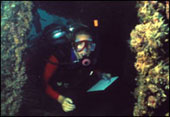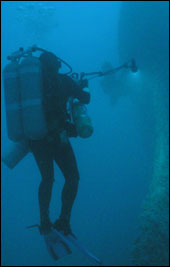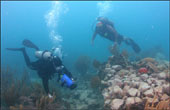|
 |
| |
Mission Logs
 April 30, 2006 April 30, 2006
Crunching data, wrapping up and heading home.
 April 29, 2006 April 29, 2006
Rough seas and small craft advisories make the going tough.
 April 28, 2006 April 28, 2006
The team explores the North America, a 19th century masted vessel.
 April 27, 2006 April 27, 2006
Today kicked off media day as the team provides an educational tour under water.
 April 26, 2006 April 26, 2006
Archaeologists kick off the photo-mosaic mission. Take a look at the newly developed sled technology in action!
Mission Home Page
|
|
|
|
Shipwreck Diving
by Cheva Heck
Florida Keys National Marine Sanctuary
A look through the pages of any dive magazine confirms it. Divers love shipwrecks. Divers also love the Florida Keys, and great wreck diving certainly helps to explain why. Hundreds of shipwrecks punctuate the ocean floor in the Florida Keys National Marine Sanctuary, and the sanctuary’s mission is to protect these resources for divers and the general public to learn from and enjoy.
 |
| Click image for caption and full view. |
Some shipwrecks lie in the clear and sunlit shallows. Now adorned with colorful corals and sponges, they serve as aquariums for a glittering panorama of tropical reef fish. Sergeant majors dart like busy bees in midwater. Small barracuda hang motionless as they lay in wait for their prey. In the shadow of the hull, a red grouper patiently waits, its mouth open as a neon goby darts in and out in a cleaning frenzy.
On a summer’s day, a diver can hover entranced over such a spot for more than an hour. Snorkelers can easily enjoy the scene floating lazily on the surface, occasionally diving down for a closer look. Somehow, these shipwrecks seem almost cheerful, as though nature has taken man’s failure and given it new purpose. Cannon, anchor and fallen mast have acquired a coralline crust, and careful examination is often necessary to pick out these manmade objects.
Many of the deeper wrecks within recreational diving depths have come to rest underwater intentionally, to provide new sites for diving and fishing, rather than through an unfortunate encounter with a jagged coral reef or an ill-fated journey through hurricane winds. Deeper depths, stiff currents and changing visibility limit these dives to those with advanced skills. For those equal to the challenge, sites such as the Duane, the Eagle and the Thunderbolt, all on the sanctuary’s Shipwreck Trail, offer world-class wreck dives.
 |
| Click image for caption and full view. |
Few sensations in diving can surpass that of descending through blue water as the wreck in its entirety looms from the ocean floor. The reward for being first off the dive boat may be a glimpse of a huge goliath grouper. Amberjacks chase swirling schools of baitfish above the ships. Stanchions and rails boast a delicate filigree of coral, anemones and sponges, hiding tiny shrimp and brittle stars. History comes alive, as the diver imagines the daily activities of those who lived aboard the ship, peering into the crew’s quarters, the engine room or the wheelhouse. Time up, the journey to the surface comes far too soon.
Beyond the reach of the casual sport diver lie the deep wrecks. An intrepid few don multiple tanks and redundant gear and practice the rigid adherence to times and decompression tables necessary to brave these depths. The opportunity to explore places few others have seen rewards their discipline and sense of adventure. Near the deck of the vessel, two hundred feet down, sharks conduct their silent patrols among deepwater fish such as blackfin snapper.
The development of technical diving protocols has led to new discoveries, as divers venture into increasingly deeper waters. Off the coast of Islamorada, a shipwreck lay in 230 feet of water, known only to charter boats as a good fishing spot. Intrigued, a group arranged to dive the spot. When the expedition revealed a near pristine shipwreck, they shared their findings with the sanctuary.
Working together, volunteer divers and National Oceanic and Atmospheric Administration archaeologists conducted several missions that revealed the identity of the ship. The discovery of the Queen of Nassau, formerly the Canadian Government Ship Canada, has added a chapter to the maritime history of not just the United States, but Canada as well.
 |
| Click image for caption and larger view. |
Stripped by salvagers and battered by centuries of heavy seas, some wrecks bear little resemblance to ships, at least to the untrained eye. In the waters near Marathon, a vibrant coral patch reef hides the remains of a shipwreck thought to date to the 17th century, no more than a pile of jumbled ballast stones and the remains of wooden timbers. With careful documentation and patient research, maritime archaeologists are working to reconstruct an image of the ship. and perhaps give it a name
Perhaps the appeal of shipwrecks for the diver lies in the questions they inspire. Fifty feet down in the remote waters of the Tortugas, the shape of a cross appears on the wall of a coral pinnacle. A closer look reveals an enormous anchor embedded in the reef. Does the ship that carried it lie buried nearby? Where did it come from? What was its mission? Who was aboard, and what thoughts flashed through the sailors’ minds as their ship went down? Though a ship may have met its fate many years ago, the diver exploring its remains feels a kinship to those who once braved the waters of the Florida Keys.
|



